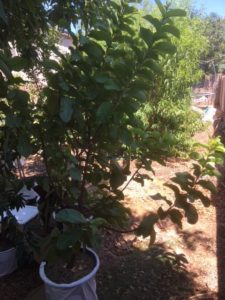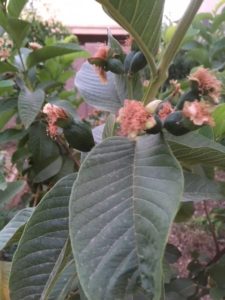Growing Tropical Guava Trees in Hot, Dry Climates

There are several types of guava varieties like Feijoa’s (Pineapple Guava), Cattley Guavas (Lemon or Strawberry), and Tropical Guava’s (White, Pink, Red). Growing tropical guava trees in hot, dry climates like my backyard in the Arizona Desert, is easier than you may think. I had no interest in the Cattley Guava types, since I’ve heard they don’t taste that great. Cattley Guavas also struggle a lot more in our heat.
Feijoa’s can do well in our hot, dry climate, but take several years to fruit.
I had tried a tropical white guava from a local grocery store and thought it tasted ok. It was pretty seedy and the seeds were almost like little pebbles they were so hard, but they still had a decent flavor.
I mail ordered a couple starter plants for cheap and initially was disappointed when they arrived in the mail. They were tiny little plants with just a couple leaves.
I went ahead and planted and through the first summer they must’ve grown 4-5 feet. It was amazing how rapidly they grew.
All my Guavas fruit twice a year. I get a crop around August and another in the spring. The spring crop tends to be the better quality, but the summer crop still has a lot of tasty fruit.
The varieties I have are Peruvian White Guava, Indonesian Seedless Guava, and Barbie Pink Guava. I wanted to make sure I had at least one pink and one white variety to try.
Peruvian White Guava
This is the best guava that I have ever tasted. I’ve only tried the three I’m growing and the store bought variety, but this is an excellent tasting fruit. It has a smooth, creamy texture, with seeds that are hardly noticeable.
It reminds me of a pear with a floral taste. This tree is planted in the ground and is in one of the hottest locations in my yard positioned against a west facing wall. It has done very well.

Indonesian Seedless Guava
The Indonesian Seedless Guava has been the more challenging of the three Guavas to grow. It tends to drop its flowers and not hold fruit. It struggles in full sun, but when growing in partial sun, seems to do a lot better. The fruit is like a Thai Guava, so you eat it more when it is crunchy. I was really excited about this tree initially, but the fruit hasn’t been my favorite. I’m hoping as the tree matures it will improve.
Barbie Pink Guava
This Guava also is an excellent choice for hot, dry climates and for container growing. It takes our sun very well and fruits pretty prolifically in a container.
The fruit are fairly large and look similar to an avocado. They turn a slight yellow when ripe. Pink guavas have more of a musky smell and you can smell them in the yard when they are ripe.
Pink Guavas seem a little less sweet to me and I like them more in smoothies or drinks.

Gardening Skill Level
Tropical Guava’s are a great beginner fruit tree for those interested in moving into tropical fruit trees. It is one of the easiest tropical fruit trees that I grow.
A tropical guava can thrive with very minimal care. It doesn’t seem very susceptible to root rot or various diseases.
Suitable for Container Growing
I’m growing my Barbie Pink Guava and Indonesian Seedless Guava in containers. I purchased them as tiny starter plants that were about 4-6 inches tall in Spring of 2016.
After two years, they’ve been transplanted into 15 gallon containers. At some point I may move them to 25 gallon containers, but that is the largest container size that I will grow them in.
My guava trees have done very well in containers. They fruited within a year and I get around 25 guavas during each guava season. After the fruit are harvested, I prune the trees way back to keep them manageable in containers.
I maintain them in the containers at around 6-8ft. I’ll root prune as needed.

Planting Tips
I make sure to heavily mulch my Guava trees. I amend my soil to help with drainage. See my post on growing fruit trees in clay soil. In a hot climate, you can pretty much plant a Guava tree all year round during the warmer months.
Watering
Many articles that I have read regarding tropical guavas indicate that guava’s are drought tolerant fruit trees. I haven’t found that to be the case.
My tropical guavas love water during the hottest summer months. The new growth tips tend to start wilting when the tree needs water. I water my guavas every other day during extreme temps.
My container guavas need water almost daily during the hot summer days.
Feeding
Tropical Guavas seem to take off when the temps increase. I’ve found that anything that tends to grow fast, usually are heavy nitrogen feeders.
I feed my tropical guava trees nitrogen based fish emulsion throughout the growing season every couple weeks. I also heavily mulch and top with compost a few times per year.
Check out the products that I use and recommend here.

Sun Exposure
I have Tropical Guavas in different areas of my yard with varying degrees of sun exposure. It seems that as long as you are giving them enough water they can grow well in any sun exposure.
I do notice some leaf scorch when in full sun all day in the hottest months. Some shade may be beneficial when the plant is getting established.
In our scorching desert sun, tropical guavas will also do well in shady areas, although I wouldn’t put them in all day shade.
Potential Problems
The main problem that I have had growing guavas in the Arizona desert is the winter cold snaps. My yard can get down to the upper 20’s a few nights a year.
My Peruvian White Guava that is planted in the ground, tends to get hit by the cold. The leaves will turn brown and crispy. When spring comes the tree leafs back out and resumes growing as usual.
I don’t usually cover my guava, but if it gets too cold, I’d recommend it. I’ve heard that Pink Guava varieties can take a little colder temps, but since my Barbie Pink Guava is grown in a container, I move it into the garage on cold nights.
Guavas can be killed at temps around the mid-20s. Guava trees can attract some pests like aphids or scale on new growth. If you monitor it, you can easily get rid of them.
Please comment below on anything you enjoyed from this post or anything about growing guava.
